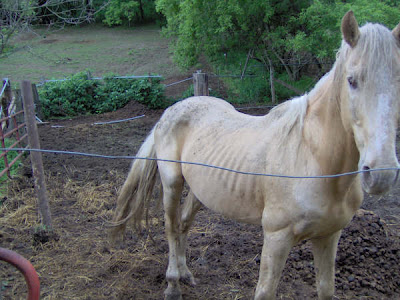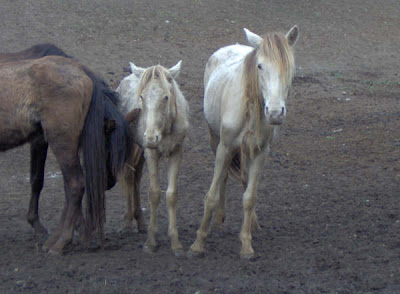Sunday, July 27, 2008
The Trempealeau Rescue - Part 1

As we walked down the overgrown trail that had once served as a driveway, my heart was pounding and my mind was racing. What would we find beyond this overgrowth? Would the horses be able to be salvaged? How wild would they be? How starved would they be? How weak would they be? How many would be down? And how would we ever get them in to our horse trailers?
It was a sunny, warm day in early June. In this valley, however, there was no breeze – only the sun beating down on our heads. The ‘driveway’ was washed out leaving only craters and boulders everywhere. Even my four-wheeled pickup would drag bottom on the drive in. The “yard” was a mess of wires and tires and overgrown brush. An old weathered and collapsed mobile home was on my left as we rounded the curve in the washed out road.
 The corral fence was really a collage of branches and pipes and bent over woven wire. And a few gates that were buried for the bottom two feet in old manure. But in that corral stood the Daddy of Them All. A twenty-something stallion that announced our arrival and began his dance of protection. He was glorious! And wild. This was his herd and he was proud of it!
The corral fence was really a collage of branches and pipes and bent over woven wire. And a few gates that were buried for the bottom two feet in old manure. But in that corral stood the Daddy of Them All. A twenty-something stallion that announced our arrival and began his dance of protection. He was glorious! And wild. This was his herd and he was proud of it!Next to him in another pen area were three more stallions. Younger and more fit and even more wild. Taking their cue from the old stallion, the valley now echoed with their warnings to the herd that strangers – no, predators! – were in amongst them! Beware!
 Just in front of us was what once had been the “field”. Now completely a dirt lot with not even a root visible. And the trees had been stripped up to the very top of the reach of the tallest member of the herd. In this field stood the majority of the herd. Twenty-one of them. Dear Lord.
Just in front of us was what once had been the “field”. Now completely a dirt lot with not even a root visible. And the trees had been stripped up to the very top of the reach of the tallest member of the herd. In this field stood the majority of the herd. Twenty-one of them. Dear Lord.They all stood together on the back line. Ears forward and eyes fixed on the predators who simply stepped over the fallen wire, bone-dry bent up stock tanks, and buried gates to approach them. Huddled together, this herd of wild horses did not bolt or make a move. Still with ears forward and eyes watching us. As we approached them we studied each other.
What did they see? They saw a small group of humans who had come together to rescue them. This group was not smelling of fear. We were curious, too. And yes, there were tears on many faces. Tears of appreciation for the determination of these horses to survive. Tears of appreciation for the emaciated leaders of this scrawny herd for doing their best to protect the weaker ones. Tears of regret that these creatures had been left to survive all on their own. And tears of relief that, at least today, many would leave this hole and begin a new life.
What did we see? We saw twenty-one sets of big eyes looking at us. Wondering. Questioning. And watching. The twenty-one bodies we saw were all undersized and severely malnourished. The manes were all snarled and twisted and their bodies were caked with dried mud. Their heads were oversized and the hipbones stuck out with ribs that were clearly visible for counting. But in this little herd, I saw no cloudy eyes, no runny noses, and no sores. This isolation had severed them well, at least in that respect.
I saw a herd that had managed to survive and had managed to survive decently well.
 Twenty-one in a single little pack. A baby barely standing and a few studs in amongst this mostly pack of mares. Some rounded tummies told me that some of these emaciated mares were carrying even more babies. Dear Lord, why had this been allowed to go on?
Twenty-one in a single little pack. A baby barely standing and a few studs in amongst this mostly pack of mares. Some rounded tummies told me that some of these emaciated mares were carrying even more babies. Dear Lord, why had this been allowed to go on?I extended my gloved hand and surprisingly, a nose came out to smell me. No touching but no running away either. A calmer group of starved, wild horses I have never seen and probably never will ever see again. It was as if they knew. They knew we were finally there. And they looked at us as if to implore us: "Where in the world had you been? Why has it taken years for you to get here? Did you realize how cold it was in the winter in this valley? And how hot in the summer in this valley? Did you realize the struggle it has been just to stay alive?"
The task of rescuing these horses had come about by my answering a single telephone call. It was in the afternoon in late May and I was walking past the telephone when it rang. And so I stopped and answered it. A Trempealeau County officer was on the line. She had called two other Wisconsin rescues and was hoping someone would take the lead and get everyone to work together to help rescue these horses that had come to her attention. Twenty-seven of them, in fact. My notes recorded her observations: “No hay, grass, or water – truly starvation; can see ribs and hips; some old; normal riding horse size; older stallion is alone and three stallions in another area; at least one stud in the herd.”
Rescue them from abandonment. It seems that a couple had lived in the mobile home on this property and had decided to move in to town. They had packed their belongings and had begun their life in the city. Leaving the property behind. And the horses. For several years, these horses were left to fend for themselves. A neighbor had finally complained about the conditions of the herd. Thank you, Neighbor.
I stood in total awe and amazement and wondered just how they had survived? I saw no carcasses around me and so assumed that so far, at least, all had survived. But how? And then the answer came. One of the herd had deposited a weak, small, but viable pile of manure on the ground. As it walked away, several others walked over and the manure was spread out to cool. As it cooled, the others used this manure for nutrition. These horses had survived by living off of each other.
My mind flashed back to the pictures I had seen at the Holocaust Museum in Washington, D.C. Those same big eyes. That same demeanor of resigned calm. The same quiet spirit of determination. That same acceptance of the situation. No energy was wasted. All energy was conserved.
The deep gash of a scar was firmly on my heart and my life had been changed forever.
The job was now in front of us to save these creatures from certain and painful death. But how to get these horses who had never been handled and were undoubtedly fearful corralled and in to the trailers? How to get them separated? And how to do that without jeopardizing the lives of the weaker ones? There were twenty-one in this main herd and nine of us humans.
A prayer began pouring out of me for strength and skills that I knew I did not possess. The task in front of us was monumental. And we nine humans were strangers to each other! But we banded together and began the risky business of rescuing these starving wild horses. Horses that had been left alone in this valley by other humans who somehow had gone on with their business of living.
Who were these rescuers? How had they come together? And how many of the twenty-one would be rescued that day? And what of the stallions? And the two on the hill? Would all twenty-seven horses make it out of this hole? The story of the Trempealeau Rescue continues next week!
Enjoy the journey of each and every day,
Sandy and The Herd
